2011 - the year when Aaron Ross published ‘Predictable Revenue’. And that changed the way B2B companies approached Outbound Sales.
Ross's outbound sales methodology promised a systematic way to generate pipeline predictably, and companies rushed to build dedicated SDR teams.
Fast forward to 2025, and the outbound sales landscape has evolved significantly - but perhaps not entirely for the better.
Today's SDRs are drowning in tasks - researching prospects, personalizing sequences, updating CRMs, and managing multiple platforms - all while trying to hit their meeting quotas.
What started with basic email automation has evolved into a complex ecosystem of sales tools - LinkedIn Sales Navigator for prospect discovery. Apollo.io for contact details. Klenty or Outreach for email sequences. Orum or Dial IQ for Calling. While these tools have made outbound sales more systematic, they have also created a new challenge: SDRs now spend more performing different activities in different tools rather than actually connecting with prospects.
A recent analysis shows that the average SDR spends just 3 hours daily on actual prospect engagement - a startling statistic when you consider their primary goal is building relationships and booking meetings.
AI is that change, fundamentally reshaping the outbound sales process.
The Current State of Outbound Sales: A Closer Look
Let's look at the typical SDR's day who runs outbound sales campaigns.
It starts with list building - the foundation of any outbound campaign. SDRs meticulously comb through tools like LinkedIn Sales Navigator, applying filters for industry, company size, and job titles.
Once they have identified potential prospects, they switch to Apollo.io or ZoomInfo to find the contact details. Each prospect needs verification - so another tool, another process.
Then comes the research phase - arguably the most time-intensive part of the process. SDRs navigate between company websites, LinkedIn profiles, trigger events, and news articles, searching for nuggets of information that could make their outreach personalized. All this information needs to be documented in their sales engagement platform before they can even think about reaching out.
Campaign setup follows, with SDRs crafting personalized email templates and LinkedIn messages. They're constantly A/B testing different approaches, adjusting cadences, and trying to find that perfect message that will cut through the noise. Tools like Klenty help automate the sending process, but the setup and maintenance still require significant manual effort.
Finally, there's the follow-up phase - making calls, responding to replies, engaging on LinkedIn, and booking meetings. By the time SDRs get to this crucial stage, most of their day is already behind them.
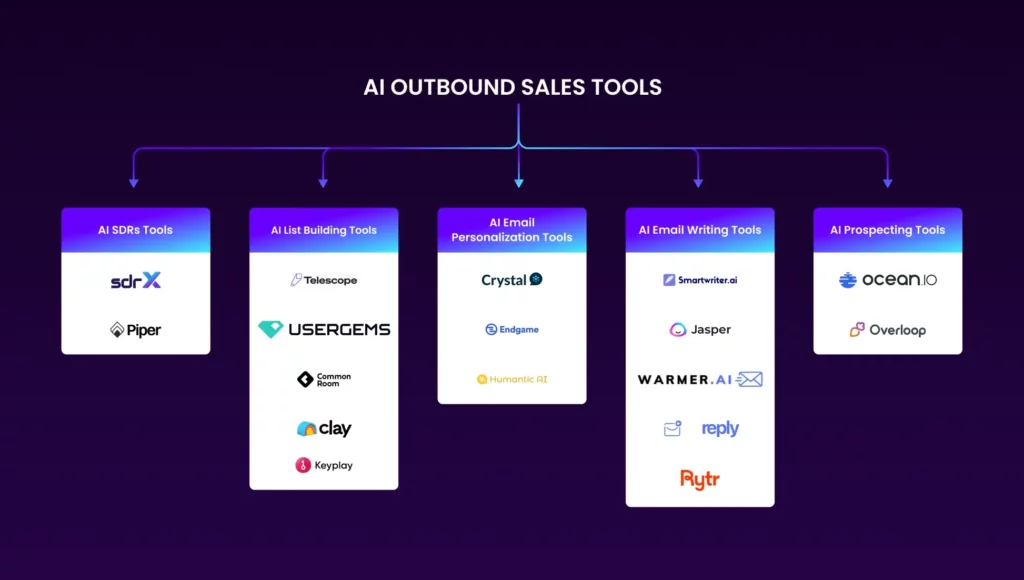
7 Crucial Problems with the Current Outbound Sales Process
Let's dig into what is really broken in today's outbound sales. These aren't just minor inconveniences - they are fundamental issues preventing SDRs from hitting their numbers and building meaningful pipelines.
1. Static Outbound Sequences
Today's outbound sequences run based on a rigid, predetermined path. You set up your sequence in Outreach or Klenty - maybe it's 2 emails, a LinkedIn connection, another email, and 2 calls, and then 2 more emails spread over 14 days. Then it runs. And runs. And runs. The same sequence for every prospect, regardless of whether they are opening every email or haven't engaged at all.
When a prospect visits your pricing page? The sequence doesn't know - it's still sending that predetermined message: "thought you might be interested" email instead of striking while the iron is hot.
Sales Sequences can't adapt in real time. It's like having a conversation where you're not listening to what the other person is saying.
2. Personalization Paradox
We all know that "I noticed you went to Stanford" or "I saw your recent LinkedIn post" style personalization doesn't work anymore. But SDRs are stuck between a rock and a hard place. Either send more emails with surface-level personalization, or spend 20 minutes per prospect digging through their company's annual report, recent press releases, and social media presence for something meaningful to say.
A typical personalized outreach today follows a predictable pattern:
"Hi {First Name}, noticed {Company} recently {announced funding/launched product/expanded to new market}. Our solution helps companies like yours {generic value proposition}..."
Despite investing 15-20 minutes per prospect on research, these messages achieve average response rates of just 1-2%. The time investment simply doesn't justify the returns, yet SDRs have no choice but to continue this inefficient process.
3. Low Call Volume
The daily target for most SDR teams generally varies between 60-80 calls. However, SDRs generally struggle to hit these numbers because of not having enough time and also because they are not using a dialer platform to help them scale dialing.
Here's what consumes an SDR's 8-hour workday:
- 2 hours on prospect research
- 2 hours on email personalization & follow-ups
- 1 hour on CRM updates
- 1 hour on LinkedIn engagement
- 2 hours left for calls
SDRs hardly get 120 minutes to make 60-80 calls which means you get around 1-1.5 minutes to call, answer voicemails, update call notes, etc. That's really hard. Also if you are not spending those 2 hours during early mornings and late afternoons (considered as the best time to call) then you are reaching out to the decision-makers when they are least likely to answer.
4. Follow-up Limitations
Here's what happens in a typical outbound sequence: Your prospect gets your first email about how your solution can help their sales team hit quota. They don't respond, so your sequence moves to the next predetermined step - maybe a LinkedIn connection request or another email about your platform's features.
But here's what's actually happening behind the scenes: That same prospect who didn't respond to your email is showing buying intent in other ways. They're checking out your pricing page, reading your integration documentation, or spending time on your customer stories. Your sales engagement platform tracks these signals, but it can't adapt to your sequence. So while your prospect is deep in research mode, exploring how your solution could work for their team, they're still getting that generic "touching base" email because that's what's next in your sequence.
Real-time follow-up becomes impossible in the current follow-up process. While you are running discovery calls or working through your daily tasks, a VP of Sales from your target account is actively engaging with your content - hitting your pricing page, checking G2 reviews, and downloading your security whitepaper. These are clear buying signals that need immediate attention. But you won't see these activities until your end-of-day activity check. By then, that VP has moved on to other priorities or is already in a demo with your competitor.
5. Extended Ramp-Up Time
When a new SDR joins, they are not just learning how to sell - they're becoming a technical specialist juggling multiple platforms. Here's what stands between a new hire and their first booked meeting:
Learning the tech stack means mastering Sales Navigator's boolean search operators, understanding Apollo's data enrichment features, configuring Outreach sequences, and navigating Salesforce's complex fields.
Beyond tools, new SDRs must internalize ideal customer profiles, learn to spot buying signals, understand competitive positioning, and develop a sense for which pain points resonate with different personas. This isn't knowledge you can pick up from a playbook - it comes from hundreds of conversations and countless hours of research.
6. The Research Time Sink
If you need to personalize with context and relevancy, SDRs need to research all the below details for each prospect:
- Scan their website for recent product launches
- Check LinkedIn for org changes and employee count
- Read press releases for growth signals
- Look up tech stack information
- Find relevant case studies
- Identify mutual connections
- Search for trigger events
This deep-dive research takes about 30 minutes per prospect. When your daily target is reaching out to 50-100 prospects, spending 30 minutes per prospect becomes impossible. As a result, most SDRs end up doing surface-level research.
Even if the research is available, there is another problem. SDRs need to weave these insights together into a compelling business narrative which feels personalized and contextual. But SDRs are forced to use each piece of information in isolation: "Noticed you use Salesforce... saw you're hiring SDRs... congrats on the funding because of the basic placeholder formats. This disconnected approach fails to show prospects how these various signals connect to their potential need for your solution.
7. Generic Sales Enablement Collateral
In today's outbound sales process, the moment a prospect shows interest - maybe they replied to your email or asked for more details during a cold call - SDRs immediately share the standard sales deck. But here's where the process breaks down.
Your prospect, a VP of Sales at a fast-growing SaaS company, asks for information about your solution. You send them the same sales deck you've sent to everyone else this week - manufacturing companies, healthcare providers, tech startups, everyone. Sure, you might swap out their logo and company name on the cover slide, but the content remains identical - same generic value props, same standard features list, same general case studies.
The deck talks about "improving efficiency" and "increasing revenue" without addressing their specific context - that they have just raised Series B funding, are expanding into new markets, and need to scale their sales team without losing momentum. When prospects see this one-size-fits-all approach, it immediately signals that you don't really understand their business or unique challenges.
How AI is Transforming the Outbound Sales Process
The increasing demand of AI SDRs represents a fundamental shift in how outbound sales teams operate. Rather than adding another tool to an already bloated tech stack, platforms like SDRx are reimagining the entire workflow.
Let's see how SDRx transforms each component of the outbound sales process.
1. Intelligent List Building
Traditional list building relies heavily on basic firmographic data - revenue, employee count, industry. SDRx elevates this process by analyzing over 200 data points per company, including:
- Technology stack compatibility
- Growth signals (hiring patterns, funding rounds, expansions)
- Digital footprint analysis
- Competitor relationships
- Buying intent signals
- Historical engagement patterns
The platform continuously learns from your successful deals, refining its targeting algorithm. Instead of spending hours finding prospects that might be a fit, SDRs now start their day with a prioritized list of companies showing actual buying intent.
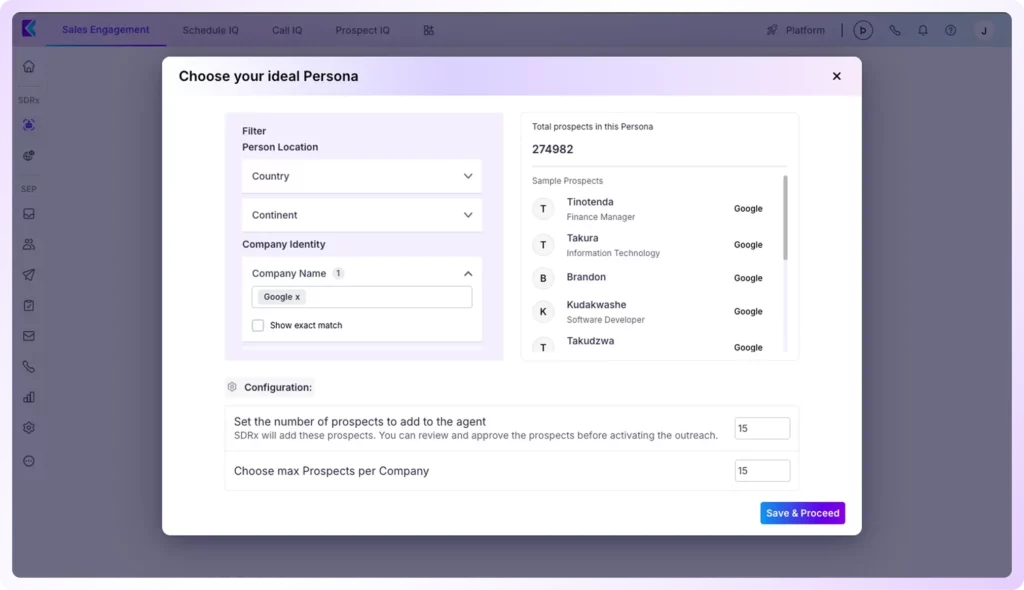
2. Research Automation
SDRx gathers data from both internal sources, such as your CRM, and publicly available external sources like LinkedIn, 10-K reports, and news articles. The platform aggregates and analyzes:
- Recent company announcements and press releases
- Leadership changes and organizational shifts
- Product launches and feature updates
- Customer testimonials and case studies
- Social media presence and engagement
- Industry-specific challenges and trends
This information isn't just collected - it's processed through AI to identify specific talking points and pain points relevant to your solution. What previously took 20 minutes per prospect now happens automatically in seconds.
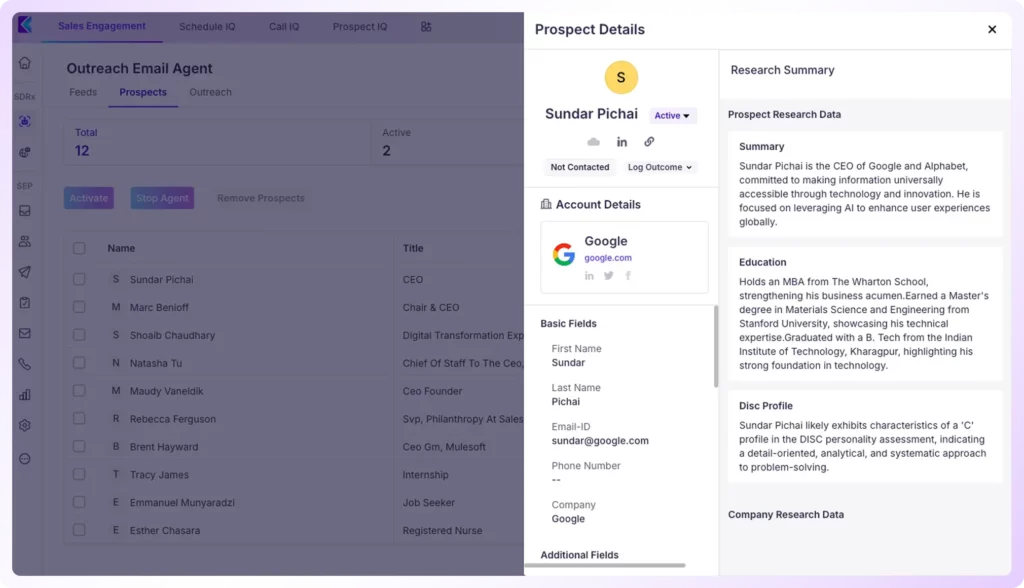
3. Email Warmups For High Deliverability
SDRx ensures email deliverability by combining multiple strategies: it warms up email accounts to build sender reputation, rotates inboxes to avoid spam triggers, authenticates messages using DKIM and SPF, controls sending frequency and volume to maintain a natural cadence, employs custom domain tracking to prevent blacklisting, and randomizes sending patterns to mimic human interactions - all while safeguarding inbox placement and engagement.
4. Multi-Channel Outreach
- Email Writing
SDRx uses 25 proven frameworks to create personalized, human-centric emails designed to achieve specific goals, such as securing meetings, increasing engagement, or driving replies. Each email is tailored based on prospect data and their stage in the buying journey, ensuring messaging is relevant, concise, and aligned with the prospect’s needs.
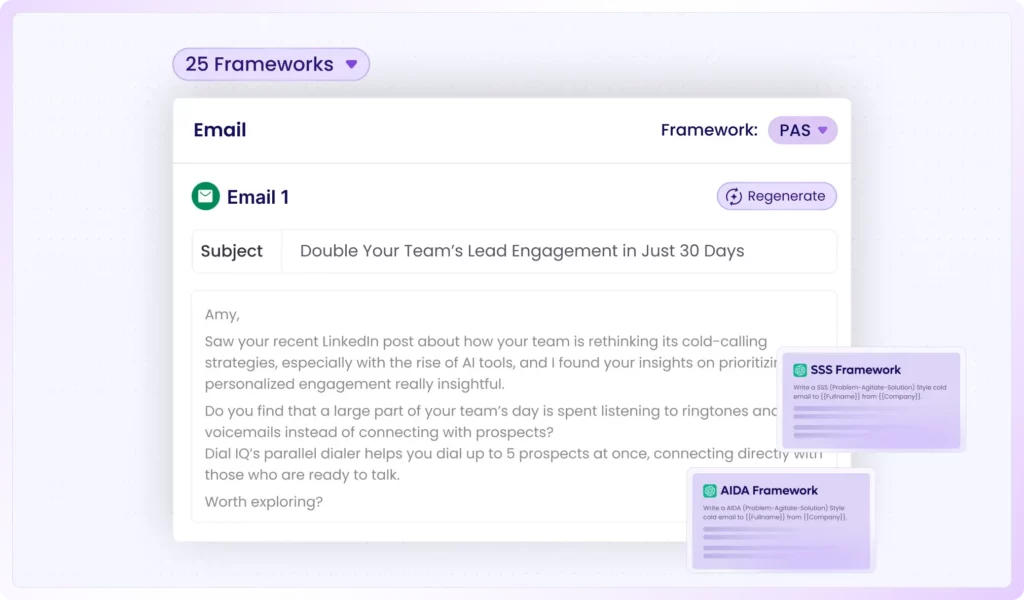
SDRx sends connection requests based on your target criteria and automatically engages with prospects who accept those requests. Messages are personalized using details from each prospect’s profile, increasing the likelihood of meaningful interactions. Unaccepted connection requests are removed after 30 days to maintain a clean outreach process.
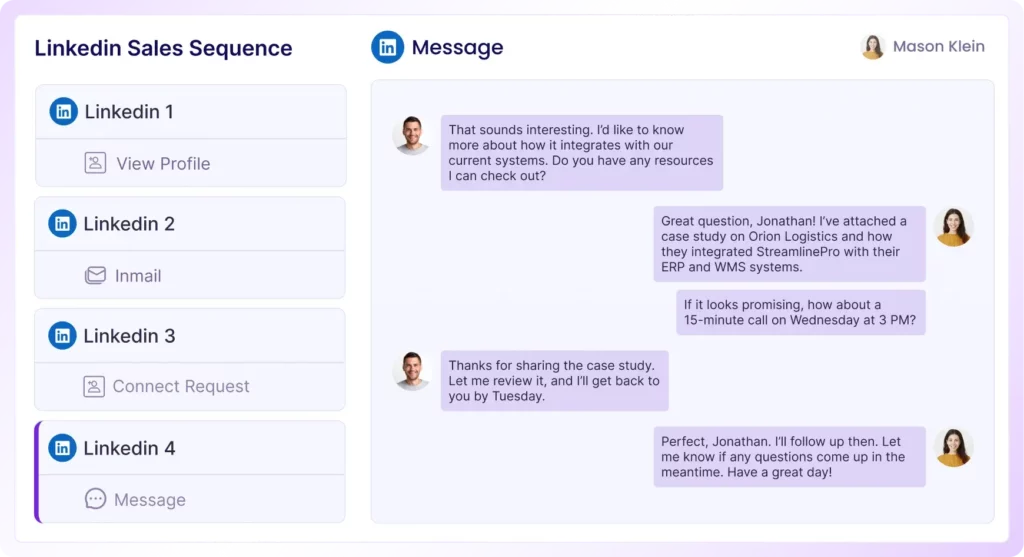
- Personalized Outreach at Account- and Prospect- Level
SDRx allows you to customize emails both at the account level and for individual prospects. It uses multiple external and internal data sources to find triggers and insights that create a relevant business case. Then, it uses prospect-level insights to personalize each email. This combination of account-level relevance and prospect-level personalization ensures that your messaging is impactful for each prospect.
- Reviewing Emails With Quality Control
With AI parameters in place, SDRx performs hallucination checks, ensures proper structure and formatting, and verifies correct links in each email. SDRx uses a research agent to validate the accuracy of the information used in outreach. After this, SDRx edits emails to meet the highest standards, ensuring each message is accurate, relevant, and aligned with the prospect’s needs.
5. Adaptive Follow-ups Aligned to Prospect’s Buying Stage
SDRx customizes follow-up timing and messaging according to the prospect's buying stage and awareness level. Your sales outreach is aligned with the prospect's decision-making process, adjusting frequency and content to maintain relevance and engagement. SDRx incorporates goal-driven follow-ups, tailoring the timing and content of each message to achieve specific outcomes - whether it's getting a reply, booking a meeting, or driving further engagement.
6. Personalized Sales Decks
SDRx automatically generates customized sales decks for each prospect in your campaign. These decks will have company-specific information, relevant case studies, and tailored value propositions based on the prospect's industry and challenges.
The platform also tracks engagement - showing who's reading what, time spent on each section, and other engagement signals that indicate buying intent. This intelligence helps SDRs focus their follow-up efforts on prospects showing the most interest.
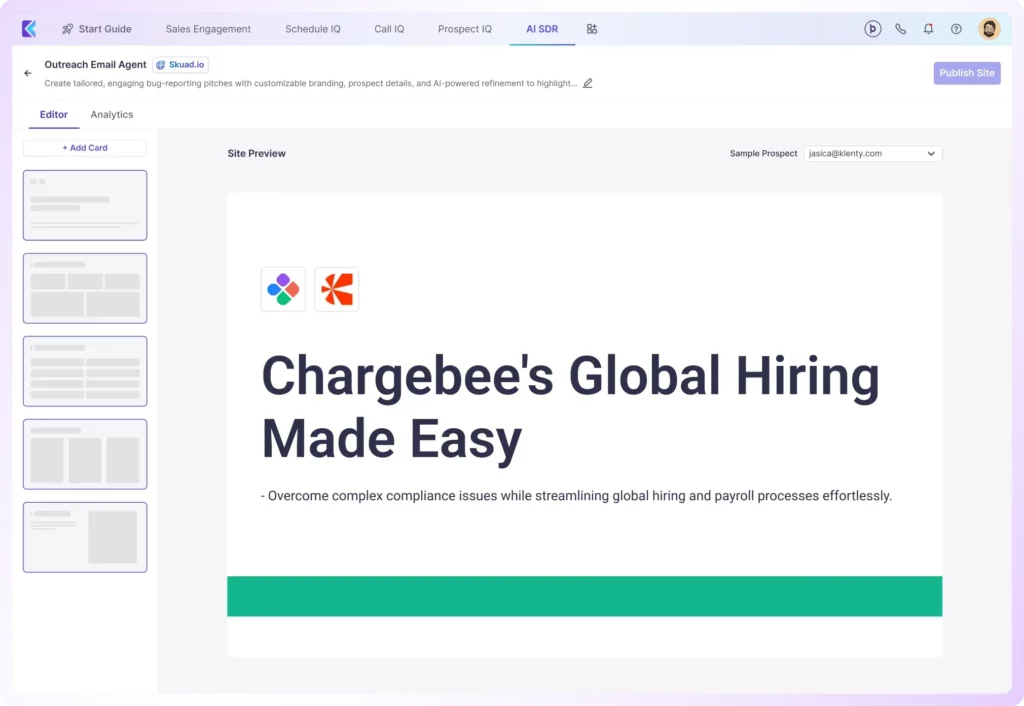
Benefits of Implementing AI in Outbound Sales Process
The implementation of AI in outbound sales isn't just about automation - it's about transforming how SDRs operate and scaling personalized outreach.
1. Truly Personalized Buyer Journeys
Traditional outbound treats every prospect identically. SDRx changes this by creating dynamic, personalized journeys:
- Each touch point adapts based on the prospect's role, industry, and engagement
- Sequences automatically adjust timing based on prospect behavior
- Content and messaging evolve as new company information emerges
- Case studies and resources are automatically matched to prospect's use case
For instance, when a prospect's company announces a new product launch, SDRx automatically incorporates this into the next touch point, making outreach timely and relevant. This level of dynamic personalization achieves 3-4x higher response rates compared to traditional sequences.
2. Research-Backed Outreach
The quality of prospect research directly impacts conversation quality. With AI automation:
- Research time drops from 20 minutes to seconds per prospect
- Each conversation is backed by 200+ data points
- Real-time updates on company news and triggers
- Competitive intelligence automatically incorporated
- Industry-specific pain points identified and prioritized
This depth of research means SDRs enter every call with comprehensive context, leading to more meaningful discussions and higher conversion rates from call to meeting.
3. Optimized SDR Performance
By automating time-consuming tasks, AI dramatically improves SDR productivity:
- Daily call volume increases from 30-40 to 60-70 calls
- Research time reduces by 85%
- Email personalization time drops by 90%
- CRM updates are automated
SDRs can now focus on what they do best - having quality conversations with prospects rather than drowning in administrative tasks.
4. Accelerated Ramp-Up Time
New SDR onboarding transforms from a 3-6 month process to weeks:
- Automated research eliminates learning curves
- Proven messaging templates are readily available
- Best practices are built into the workflow
- Focus shifts to conversation skills vs. technical setup
This acceleration in ramp-up time means new SDRs can start contributing to pipeline generation significantly faster.
AI SDR + Humans SDRs = The Future of Outbound Sales
AI is transforming how B2B companies run their outbound sales. AI SDRs like SDRx aren't here to replace human SDRs - they take over the repetitive tasks like prospect research, personalizing messages, and managing follow-ups, letting SDRs spend more time on what they do best.
When AI handles these time-consuming tasks, SDRs can focus entirely on having meaningful conversations and converting prospects into opportunities. With buyers expecting more personalized outreach than ever before, combining human SDRs with AI capabilities isn't just a nice-to-have - it's becoming essential for sales teams running outbound sales.


